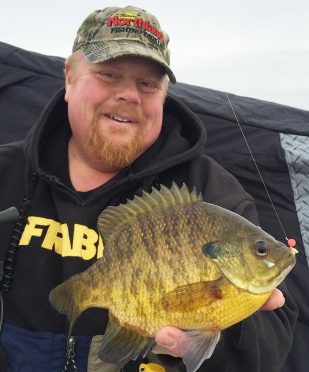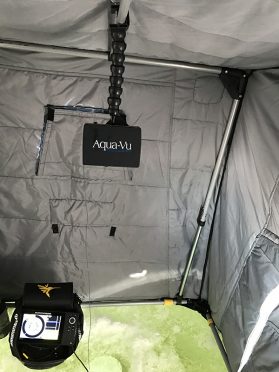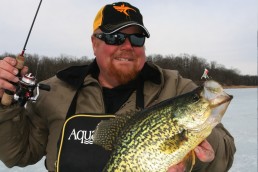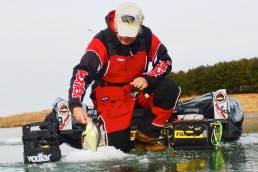See the Fish Catch the Fish: Underwater Ice-Fishing Cameras
SHARE THIS POST
The cutting-edge approach to midwinter ice-fishing
November and December are the cloudiest months of the year, with both months averaging around 18 days of cloudy weather. Once January arrives, the clouds largely leave. Clear skies and bitter cold are more the norm in the northernmost parts of the ice belt. January has the coldest average temperatures of the winter, which can put the brakes on the early ice bites for both gamefish and panfish. Especially during the long stretches of below zero temperatures, you might not see the fish biting.
The good news is, the ice is usually thick enough for vehicle traffic by January in my part of the country. That allows anglers to spread out on the lakes. Deep snow and ice heaves are the two most likely obstacles for anglers to deal with in January. Well, that along with cold and a tough bite for most species of fish.

Bad winter bite
Fish still have to eat, regardless of weather and ice conditions. The midwinter blues often include extra-finicky, sluggish fish that will barely move the tip of your rod. Even if you do get them to bite. I like to use the super-sensitive Quicktip 25-inch Bro Series Rod that I designed for Frabill. I pair it with a 371 Straightline reel, spooled with 2-pound-test line for panfish. This gives my lures the most natural presentation possible. By using straightline reels, anglers reduce lure spin, which often spooks finicky fish.
Seeing is believing when the bite is tough. Sight fishing has some anglers hooked. However, that only works when the fish are shallow. And, then, only when the water is clear enough for anglers to see the bottom. Anglers who sight-fish also have to be in a house that is completely dark inside. Sitting over a small hole, using an extremely short rod, and staring down into the water to see your lure and fish? That’s truly a recipe for a sore back and tough fishing. Today, however, there’s another way to see bites with your own eyes. And you don’t have to fish shallow water from a completely dark fish house, either.
New ice fishing cameras help you see the fish
Employing the new generation of underwater ice-fishing cameras is like sight fishing, only better. You don’t have to lean over the hole trying to see the bites and you still know when to set the hook. When I first started using an Aqua-Vu ice-fishing camera, way back in 1997, the cameras were a super-cool innovation and everybody wanted one. The problem was, the units were in black and white, heavy, and awkward to use. The cables were also a problem. They would get tangled and catch on the ice when anglers tried to move from hole to hole without first wrapping up the cable. The old cameras were good for seeing the bottom, but the picture was not very clear and the cameras were not very user friendly.
Fortunately, technology keeps evolving and ice fishing cameras have come a very long way. The Aqua-Vu Micro 5 ProRevolution underwater ice fishing camera, for example, is compact and delivers a clear color picture. Portable and easy to handle, it can take the ice angler to the next level. The Micro 5 fits in the palm of your hand. With its high-definition camera and a built-in reel to wind up and let out the cord it’s fast and easy to use.

Up, down, side-to-side
Anglers can set the camera lens in three positions: Up Viewing, Down Viewing or Side Viewing. This allows anglers to fish the entire water column effectively. I use Up Viewing mostly for shallow water and weeds to look towards the surface of the ice. Looking through the weeds, I can see the fish and the bait at the same time.
Are you enjoying this post?
You can be among the first to get the latest info on where to go, what to use and how to use it!
Down Viewing works when fish are in deeper water and close enough to the bottom that I can use the bottom as a backdrop. Having the camera lens positioned above the fish also helps reduce the chances of spooking the fish with the camera head or wire.
Side Viewing usually works best when the fish are suspended farther from the bottom. Or, when I hunker down in my Frabill Bro Series Side Step. Note the “Bro” part of the name. Yes, I designed it. It’s worth mentioning the model because this house gives me enough floor space to drill a separate hole for the Aqua-Vu. This gives me the perfect viewing position to watch one or more lines with the camera a safe distance away.
No intuition needed
Using an Aqua-Vu to actually see the fish is like sight fishing at any depth. Anglers don’t have to rely on “feel” to know when to set the hook. They actually see when the fish takes the bait. Cameras also give us instant feedback on how the fish are reacting to our baits. Sedentary bluegills, for example, might chomp your bait three or four times before the hook gets in their mouths. A camera shows you when setting the hook will actually hook them.
Seeing is believing. Anglers will know the type and size of the fish they are dealing with because they can see them on the camera. This does not mean anglers no longer need to use sonar while ice fishing. The engineers at Humminbird have also been busy. The new Ice Helix 7 G2 comes with Chirp technology to separate individual targets like never before and Smart Strike, which helps even rookie anglers fish like a pro. I had a prototype of one of the new Humminbird units last winter, but I was strongly advised not to let other people see it. So, it was like having a secret weapon that nobody else knew about.
Now I can talk about the new Humminbird units all I want, so come and see me at one of my stops on the Bro Road Show. I’ll show you what all the fuss is about in person.
Get mo’ from Bro
“Bro” is in the know. Get more ice-fishing tips from Brian “Bro” Brosdahl in his article on deadsticks.
Brian “Bro” Brosdahl is a nationally known fishing guide and lead spokesman for many top angling companies. He can be contacted at bbro@paulbunyan.net or through his website at brosguideservice.com. Follow him on Instagram, Twitter and Facebook. Brosdahl can be seen across the Ice Belt in a store near you during the Bro Road Show. Be sure to check Bro’s social media pages for more information about dates and times.
MWO
SHARE THIS POST
You may also like...
Did you enjoy this post?
You can be among the first to get the latest info on where to go, what to use and how to use it!
Brian 'Bro' Brosdahl
Outdoor communicator Brian “Bro” Brosdahl lives in northern Minnesota. He is a walleye guide in the Cass Lake, Leech Lake and Lake Winnibigoshish areas. He is sponsored by Northland Fishing Tackle, Frabill/Plano, Aqua-Vu, Humminbird/Minn Kota, St. Croix Rods, Ranger Boats, and Evinrude. Guide inquiries: brosguideservice.com. Follow on social media.


